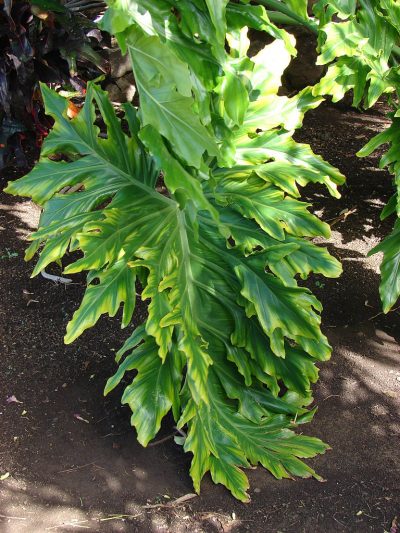






Fiddleleaf philodendron is a large foliaged houseplant that grows up trees in its natural habitat and requires supplemental support in containers. Where does fiddleleaf philodendron grow? It is a native of the tropical rainforests of south Brazil into Argentina, Bolivia, and Paraguay. Growing fiddleleaf philodendrons in the home interior brings the experience of a hot, steamy forest filled with exotic flora into your home.
Fiddleleaf philodendron is scientifically known as Philodendron bipennifolium. The philodendron is an Aroid and produces the characteristic inflorescence with a spathe and spadix. As a houseplant, its glorious cut foliage is a showstopper and its easy growth and low maintenance assign it ideal houseplant status. Fiddleleaf philodendron care is simple and uncomplicated. This is a truly lovely indoor plant with volumes of appeal.
Once of the more important items of Philodendron bipennifolium information is that it is not a true epiphyte. Technically, it is a hemi-epiphyte, which is soil grown plant that climbs trees with its long stem and the assistance of aerial roots. This means staking and tying in a home container situation to keep the plant from flopping over.
The leaves are fiddle or horse-head shaped. Each can reach 18 inches to 3 feet in length with leathery texture and glossy green color. The plant is mature and ready to reproduce in 12 to 15 years in ideal climates. It produces a creamy white spathe and tiny round ½-inch green fruits. The plant is unknown to reproduce in interior settings or in hot, dry climates.
The tropical houseplant requires warm temperatures and has no cold hardiness. Once you answer, “Where does fiddleleaf philodendron grow,” the tropical nature of its native land becomes a signature for its care.
Fiddleleaf philodendron care mimics its wild range and native land. The plant prefers moist, humus rich soil and a container large enough for the root ball, but not excessively large. More important is having a stout stake or other support for the thick trunk to grow up. Fiddleleaf philodendrons can also be grown downwards as trailing specimens.
Mimicking the native climate also means placing the plant in a semi-shady location. As a forest denizen, the plant is an understory species, which is shaded by taller plants and trees most of the day.
Caring for fiddleleaf philodendrons basically rests on a consistent watering regimen, occasional dusting of the big leaves and removal of dead plant material.
Reduce watering a bit in winter but, otherwise, keep the soil moderately moist. Provide support structures for this philodendron when training them up vertically.
Repot fiddleleaf philodendrons every few years to energize the plants with new soil but you don’t have to increase the size of the container each time. Fiddleleaf philodendron seems to thrive in tight quarters.
If you are lucky enough to have your philodendron produce a flower, check out the temperature of the inflorescence. It can hold a temperature of 114 degrees Fahrenheit (45 C.) for up to two days or as long as it is open. This is the only example of a plant controlling temperature known.
Propagating giant philodendron
Learn All About Backyard Landscaping
Wildflower Meadow Maintenance: Learn About End Of Season Care For Meadows
Coffee Plant Care – Growing Coffee Plants Indoors
Philodendron Houseplants: How To Care For A Philodendron Plant
Cold Climate Vermiculture: Learn About The Care Of Worms In Winter
Copyright © www.100flowers.win Botanic Garden All Rights Reserved